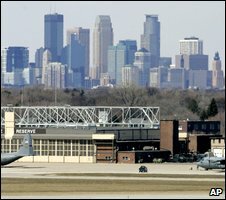Deadly journey: Minneapolis to Mogadishu
 Minneapolis is very different from Mogadishu. Yet it is home to the largest group of Somali refugees in the country – more than 60,000 of them. It may seem like an odd place to settle if you are from the Horn of Africa.
Minneapolis is very different from Mogadishu. Yet it is home to the largest group of Somali refugees in the country – more than 60,000 of them. It may seem like an odd place to settle if you are from the Horn of Africa.
In autumn, Minnesota is cold and grey; in winter it is almost too cold to venture out.
But unlike Somalia, there is no civil war here, no children walking around with guns, no warlords and none of the grinding poverty.
So it seemed like a safe place for Zeinab Bihi to raise her son, Burhan, or so she thought.
On 4 November 2008, the 17-year-old went missing from their Minneapolis apartment.
Zeinab describes the day: first Burhan’s school called to say he had missed class; she phoned around to see if he was with friends, or at the mosque; then she checked his bedroom and found that his laptop, passport and clothes were missing. She contacted the police.
Burhan had gone to Somalia. His mother was shocked. She still is.
“He was a young kid, he doesn’t know Somalia, he doesn’t speak Somali. He didn’t know anything that was going on over there!”
And the news didn’t get any better. Six months after leaving home, Burhan was dead.
His mother believes he was murdered by militants as he tried to escape from their clutches. The same Islamic extremists who she believes had recruited him and others in Minneapolis.

Jamal’s mother found out he was dead via a Somali website
|
Zeinab tells me that Burhan was shot because he refused to take part in a suicide mission.
“They gave him the order to explode himself and he refused,” she says.
Sitting beside her is Abayte Ahmed, another mother who has lost her child. She found out her son Jamal was dead when her husband saw a picture of him on a Somali website.
Jamal was lying dead on the ground and had been shot in the head.
These teenagers probably knew more than they let on to their mothers about the situation in Somalia.
At the time they left, Islamist militants were trying to wrest control of the country from government forces backed by the Ethiopian army, which had invaded Somalia with the tacit support of the US.
And Burhan and Jamal were not alone. Over the past 18 months as many as 20 young Somali men have left the comfort of their new home in America to return to a war-torn Somalia.
FBI investigation
As a result, the FBI has now launched “one of its most significant terrorism investigations since 9/11″. But the investigation is not born out of a fear of what is happening in Somalia itself.
It is more to do with the fear that young Somali men with American passports will return to the US to commit acts of terrorism.
FBI agent EK Wilson admits “there’s no credible, specific threat that their intent is to return to the US to carry out a terrorist attack on US soil”, before adding “but we can’t rule it out”.

Most Minneapolis mosques do not want to talk about al-Shabab
|
Attention has focused on one group in particular: al-Shabab. In Arabic it means “the youth”.
Sounds innocuous enough, but it is a radical Islamist organisation with links to al-Qaeda and listed by the US state department as a terrorist group.
Evidence of al-Shabab’s activities on the ground are hard to find in Minneapolis.
But, you can see its presence on the internet where it has posted videos.
The propaganda carries a distinctly anti-American message, but it is also clearly designed to appeal to young Muslim men who have grown up in the West.
Burhan’s uncle, Abdirizak Bihi – who is also a Somali community organiser – says al-Shabab is working hard behind the scenes, recruiting and raising money for one-way trips to Somalia. Mr Bihi says that reports of 20 missing Somali men are just the “tip of the iceberg”.
Most mosques in Minneapolis do not want to talk to the media about al-Shabab.
But some imams have taken a stand against the group’s extreme views and co-operated with the authorities. There is, however, also a sense in the community that the problem has been exaggerated.
One young Somali man at a mosque told me he thought the investigation was being pursued for domestic political reasons – to show that the authorities were treating any potential terrorist threat seriously.
In his words, to give the impression that “things are under control”. That is scant comfort to the families of the missing.
They are still searching for answers. Why did young Somali men – who had grown up in America with a bright future before them – suddenly leave home? And why did they never come back?
Comments
comments
 Calendar
Calendar






































